Background: World is witnessing the impact of COVID-19 on all facets of life, in all countries and all industries. During the lockdown, Indian industries made employees ‘Work from Home’ and also schools and colleges practiced ‘Online’ mode of education as per Government mandate. Since people are using more of laptops and computers during COVID outbreak for a period of time, it may result in deliberating injuries. The high prevalence of computer related musculoskeletal disorders are reported. There is a need to identify interventions that will reduce the severity and prevent impairment.
Objective: The study was designed to find the prevalence of musculoskeletal disorder and further will elucidate most common disorder faced by computer users during COVID-19 lockdown.
Methods: Total 145 respondents were contacted to fill Standardized Nordic questionnaire which was converted into web- based survey- Google forms and was circulated on social media platforms. Only 100 participants (Males = 49; Females = 51) with Mean Age (SD) = 26.33 (5.81) years) were selected based on using computer more than 4 hours.
Results: Participants who experienced pain, numbness, musculoskeletal discomfort were recorded. It showed that majority of subjects struggled from discomfort in neck (70%), lower back (60%), upper back (50%) and shoulder (49%). In past 12 months. Maximum activity limitation occurred due to pain and discomfort in neck region (39%) followed by lower back, knee and ankle (11%). The less commonly involved regions were hips/ thigh (2%), shoulder (4%), elbow and wrist (8%) followed by upper back (10%). Most commonly involved regions acutely (past 7 days) were shoulder problems (56%) followed by pain in neck (43%), lower back and upper back (36% & 30% respectively) leading to activity limitation whereas the least troublesome areas being elbow (1%), knee (9%), ankle and foot (10%)
Conclusion: Almost all participants suffered from atleast one episode of disabling musculoskeletal pain in past 7 days. Early identification, prevention and management strategies need to be explored to improve overall health in this scenario.
computer users, covid-19, musculoskeletal disorders (MSD’s)
World is witnessing the impact of COVID-19 on all facets of life, in all countries and all industries. During the lockdown, Indian industries made employees ‘Work from Home’ and also schools and colleges practiced ‘Online’ mode of education as per Government mandate. Since people are using more of laptops and computers during COVID outbreak for a period of time, it may result in deliberating injuries and high prevalence of computer related musculoskeletal disorders [1]. The prevalence of work-related musculoskeletal disorder reported in many countries increased steadily within the past decade [2] most injuries were due to typing or key entry, repetitive tool use, repetitive grasping, pushing or moving objects other than tools. According, to a conservative estimate by the National Institute for Occupational Safety and Health (NIOSH), work related musculoskeletal disorder [3] cost the United States Industry more than $13 billion per year.
Musculoskeletal disorders (MSD’s) refer to injuries affecting the soft tissues of neck, shoulder, elbow, wrist, hand, fingers, back, hip, knee, ankle [4]. These also include the nerves (e.g.-carpal tunnel syndrome etc.), tendons (tenosynovitis, epicondylitis etc.) and muscles (e.g. - tension neck syndrome and many more) [5] Jobs that involve repetitive or static awkward deviations (i.e. wrist flexion, wrist extension, ulnar or radial deviations) have demonstrated greater likelihood [6] for MSD’s.
The rise in computer use have resulted in soft tissue injuries [7]. The risk factors associated with computer work include the integration of biomechanical factors such as static muscular overload [8], repetitive motions and conditions related to work environment. The most common musculoskeletal complaints are pain and stiffness in various regions of body including neck, back, shoulders [9], wrists, etc. These problems are commonly associated with old age but due to many factors such as poor component design, proximity of the user to the screen and an excess of consecutive working hours [10] means that these problems can feature both in young and old computer users.
During the pandemic outbreak, people have adapted themselves for long hour’s usage of computers and laptops such as, working studying and also entertaining at home. Since more students use computers during outbreak of COVID-19 for online classes, completing assignments, internet use, playing games and for entertainment purposes; they reported similar symptoms as reported by occupational computer users [11] which accumulate over a period of time resulting in debilitating injuries. The high prevalence of computer related MSD’s by students suggest a public health need to identify interventions that will reduce symptom severity and prevent impairment.
Thus, arises need to study the incidence of musculoskeletal disorders and identify severity of symptoms to prevent impairment. The aim of our study was to determine the prevalence of musculoskeletal disorder among computer users during COVID-19 lockdown and identify the most common symptom and region involved.
Inclusion criteria
• Individual should be above the age of 18 years.
• Individuals using computers for more than 4 hours.
Exclusion criteria
• Individuals below the age of 18 years are excluded from the study.
• Individuals using computer for less than 4 hours.
Instrumentation
Standardized Nordic questionnaire was used to know the incidence of MSD’s in computer users. This questionnaire has the sensitivity of 66-92%; specificity of 71-88%; validity of 0.87. It was a tool developed from a project funded by the Nordic Council of Ministers [12]. There were two sections in the questionnaire.
Section 1: General questions of 40- forced choice items identifying areas of body causing MSD’s. Participants were asked if they have any musculoskeletal trouble in past 12 months and last 7 days which has prevented normal activity.
Section 2: Additional 25 questions (forced choice) to elicit any accidents, functional impact at home or work, duration of work, duration of problem, change of duties etc.
Standardized Nordic Questionnaire has been applied to a wide range of occupational group to evaluate MSD’s including computer and call center workers [13] car drivers, forest workers and many more. The questionnaire was available from the original paper by Kuorinka et al. [12] and from Evaluation of Human Work, a Practical Ergonomics Methodology [14].
Data collection
As during the COVID-19 outbreak, Standardized Nordic questionnaire was converted into web- based survey- Google forms. It was circulated on social media platforms. Participants were given brief introduction about the study and were assured of confidentiality of data. The participants gave their consent and then proceeded further.
Study tool
Data was collected with help of google forms and was converted into Microsoft excel sheets. Microsoft excel 2010 was used to generated pie charts and bar graphs.
Socio-demographic factors
A total of 145 responses were collected through web based survey. Out of which 100 responses met the inclusion criteria (Figure 1). 45 were excluded as the number of working hours on computer were less than 4 hours.
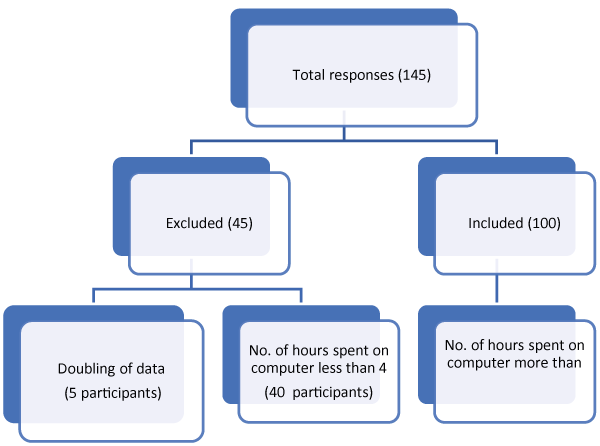
Figure 1. Overview of the participants
The mean and standard deviation of age, height, weight and BMI were described as follows (Table 1):
Table 1. Demographic characteristics
Demographic Characteristics |
Mean ± SD |
AGE (years) |
26.33 ± 5.81 |
Height (cms) |
164.75 ± 9.51 |
Weight (kgs) |
67.35 ± 13.59 |
BMI (kg/m2) |
24.79 ± 4.66 |
Gender distribution
The gender distribution of the included 100 participants were 51females and 49 males. (Graph 1).
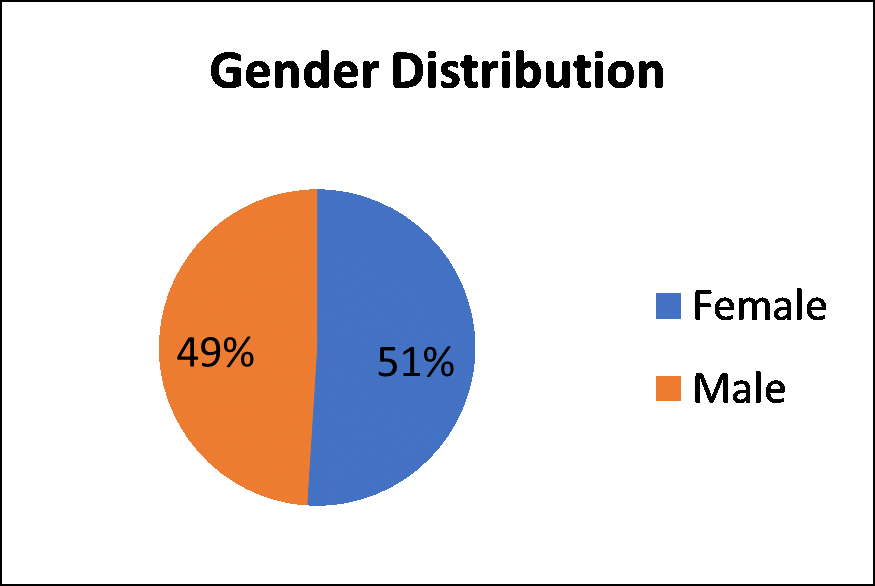
Graph 1- Gender distribution.
Body mass index
Body mass index (BMI) is a convenient tool to categorize the person as underweight (BMI below 18.5 kg/m2); normal ( 18.5- 24.9 kg/m2); overweight (25-29.9 kg/m2); obese (above 30 kg/m2) [14]. 5 participants fall under the category of underweight; 49 were normal; 36 overweight and 10 obese. (Graph 2).
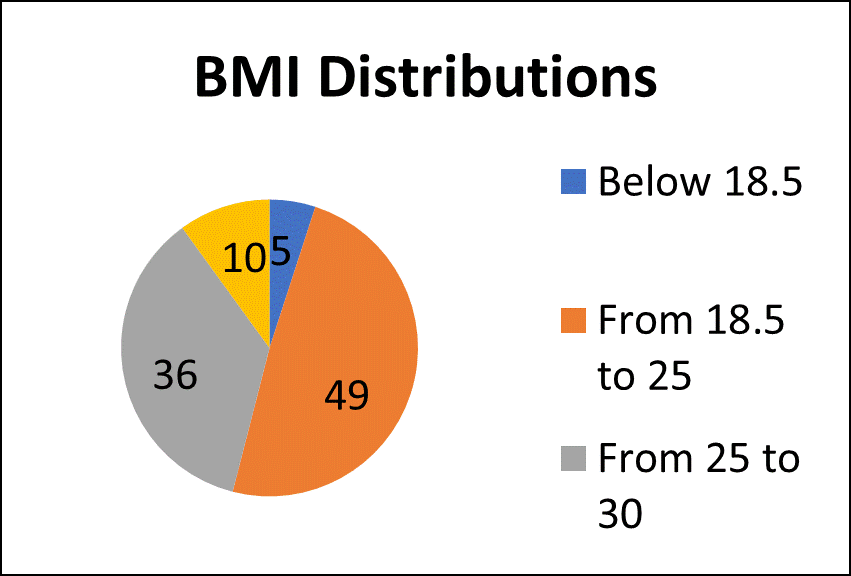
Graph 2 - Body mass index readings
Hand dominance
In human biology, handedness is important for faster, better, or more precise performance. which is achieved by dominant hand. 95% people were right-handed and 5% left-handed. (Graph 3)

Graph 3- Hand dominance of the participants
Past 12 months
Pain, numbness, musculoskeletal discomfort: Participants who experienced pain, numbness, musculoskeletal discomfort were recorded. Table 2 showed that majority of subjects struggled from discomfort in neck (70%), lower back (60%), upper back (50%) and shoulder (49%) in past 12 months. (Graph 4).
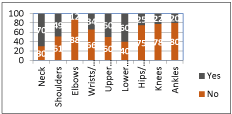
Graph 4- Demonstration of the distribution of musculoskeletal discomfort in past 12 months.
Table 2. Overview of participants experiencing musculoskeletal discomfort in past 12 months
|
NECK |
SHOULDER |
ELBOW |
WRIST/HANDS |
UPPER BACK |
LOWER BACK |
HIPS/
THIGH |
KNEE |
ANKLE |
No |
30% |
51% |
88% |
66% |
50% |
40% |
75% |
78% |
80% |
Yes |
70% |
49% |
12% |
34% |
50% |
60% |
25% |
22% |
20% |
Activity limitation
It is a dimension of health/disability capturing limitation in performing any task. The activity limitation of body parts were recorded (Table 3) of each segment explained in the Standardized Nordic Questionnaire.
Table 3. Activity limitation in past 12 months
|
YES |
NO |
NECK |
39% |
61% |
SHOULDER |
4% |
96% |
ELBOW |
8% |
92% |
WRIST/HAND |
8% |
92% |
UPPER BACK |
10% |
90% |
LOWER BACK |
11% |
89% |
HIPS/THIGHS |
2% |
98% |
KNEE |
11% |
89% |
ANKLE/FOOT |
11% |
89% |
Maximum activity limitation occurred due to pain and discomfort in neck region (39%) followed by lower back, knee and ankle (11% each). The hips/ thigh (2%), shoulder (4%), elbow and wrist (8%) followed by upper back (10%) were least responsible for activity restriction as described in Graph 5.
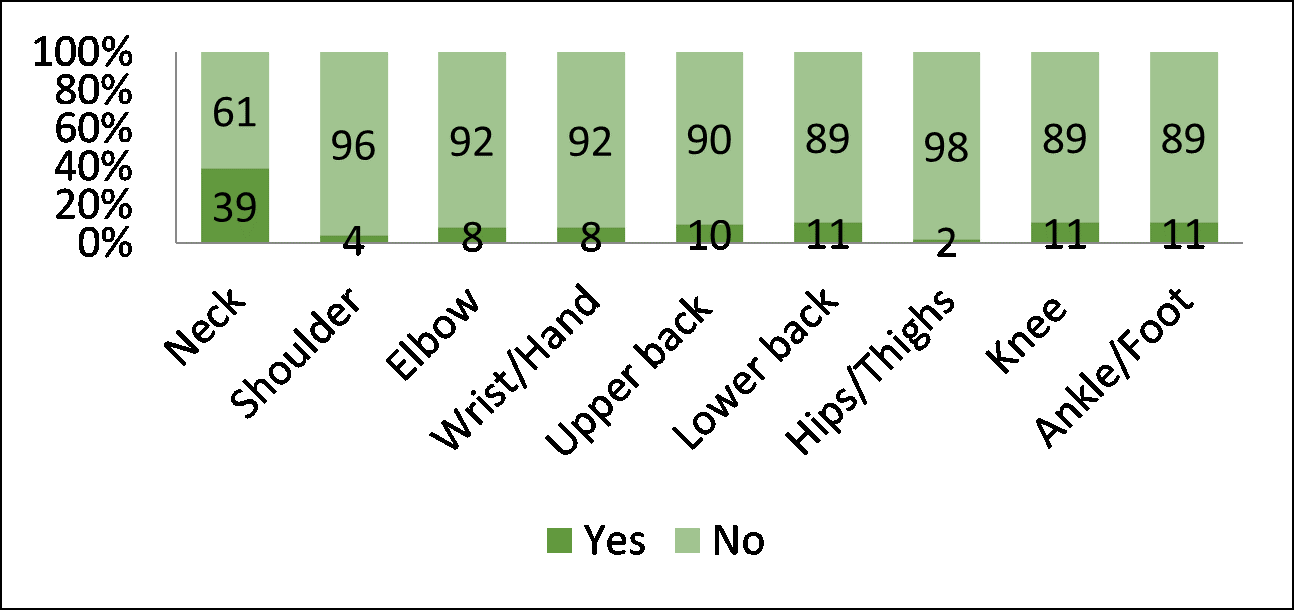
Graph 5- Graphical representation of activity limitation in past 12 months
Past 7 days: The musculoskeletal discomfort of the computer users for more than 4 hours were recorded and noted for MSD’s in different body segments (Table 4). It was observed that maximum subjects suffered from shoulder problems (56%) in last 7 days followed by neck (43%) and lower back and upper back (36% and 30% respectively). The least troublesome areas being elbow (1%), knee (9%), ankle and foot (10%) as described in Graph 6.
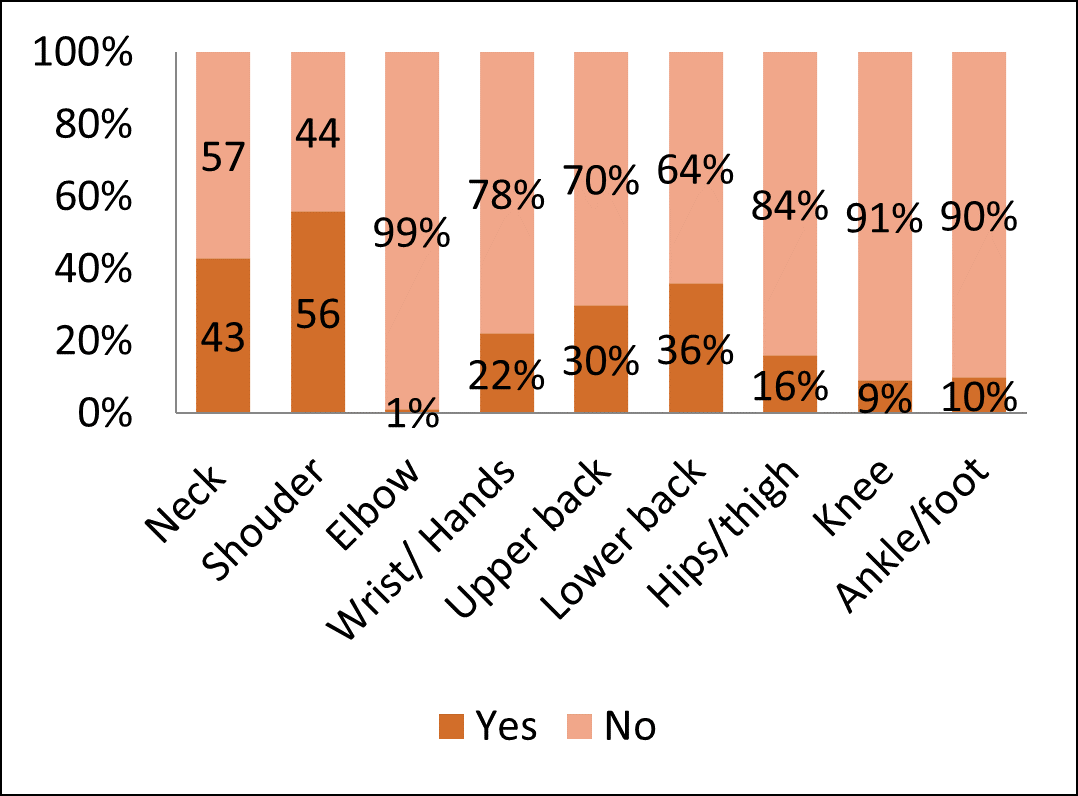
Graph 6- Graphical representation of trouble in body segment in past 7 days.
Table 4. Incidence of Trouble in past 7 days
|
Any trouble in past 7 days? |
YES |
NO |
Neck |
43% |
57% |
Shoulder |
56% |
44% |
Elbow |
1% |
99% |
Wrist/hand |
22% |
78% |
Upper back |
30% |
70% |
Lower back |
36% |
64% |
Hips/ thighs |
16% |
84% |
Knee |
9% |
91% |
Ankle and foot |
10% |
90% |
Socio-demographic factors
In present study the majority of participants were of the age group 20-35 years (91%) using computers for more than 4 hours for studying and work purpose. The majority of participants were students and office workers. In a study [9] conducted by Jannatbi et al 2016 majority (75.37%) of participants [7] belong to the age group of 20-22 years studyingComputer science where majority of the participants (61.2%) were using computer for more than 3 hours. In another study [14] conducted by Eric et al 2006 [14] Electric Engineering and Computer Science graduate students of a university majority (85%) belong to an age group of 20-30 years.
Majority of participants were females (51%), Followed by males (49%). Further, Body mass index in majority participants (49%) were normal and only 36 % were obese (36%). Body mass index affects the health of human population in large ratios causing an impact on the individual as well the community and is widely linked with many health conditions like heart diseases, stroke, diabetes, infertility, asthma, high blood pressure and many more.
Study Subjects of past 12 months in relation with standardized Nordic Questionnaire
According to the standardized Nordic Questionnaire the musculoskeletal troubles (pain, numbness, tingling etc.) and the activity limitation (difficulty in performing any task) were recording of 9 joint segments (neck, shoulder, elbow, wrist/hand, hips/thighs, upper back, lower back, knees and ankle/foot). It was found that majority of people suffered from neck (70%), lower back (60%), upper back (50%), shoulder (49%) wrist and hand (34%) discomfort. Study conducted by Rempel et al 2013 [6] found that majority participants suffered from hand/wrist discomfort (90%) followed by shoulder (60%) and neck (44%). Speaking, of activity limitation the majority experienced limitation in neck (42%), shoulder (27%), elbow (25%) and wrist (24%). He stated that computer- related risk factors demonstrating a consistent relationship with MSD’s include computer use with sustained awkward posture, long duration use of computer and work organization factors.
Study subjects of past 7 days in relation with Standardized Nordic questionnaire
The standardized Nordic questionnaire records the trouble caused by the body segments in last 7 days. Our study indicates that maximum participants suffered from troubles in shoulder (56%), neck (43%), lower back (36%), upper back (30%), wrist/hand (22%), the least affected joint segments were elbow (1%), knee (9%), ankle and foot followed by hips and thighs (10 and 16%) respectively. Study done by Jannatbi [7] et al 2016 showed majority of troubles in past week were in lower back (28.64%), upper back (25.12%), neck (21.6%) and shoulder (21.35%) which were statistically highly significant [9].
The present study reveals that 1% of participants suffered from the musculoskeletal discomfort in all joints in past week. Other’s reported either no complaint or complaint in some joints.
Association between Standardized Nordic Questionnaire and body posture
Standardized Nordic questionnaire comprises of the body posture of the individual which states that most people sit for long hours in the similar position where there trunk or head are in asymmetrical position. Abnormal body posture is responsible for mechanical body pain so there should be some virtual methods in COVID-19 phase to educate the individual about postural benefits as well as about the do’s and don’ts regarding postural maintenance. Certain web-based seminars can be conducted using various online platforms to educate the individual about the importance of posture and prevent the occurrence of MSD’s.
Association of Standardized Nordic questionnaire with job demand and social support
COVID-19 has globally affected most of the people working from home and the job demand on virtual platform has increased. Students have to take online classes as education is the integral part of the system. It is very important to develop a social support towards the individual to avoid the mental stress, anxiety and depression to live in comfortable environment and focus on job demand and progress.
Limitations of the study
The body chart measure could not be used of the SNQ as it was converted in the web-based survey. The sample size was small. It was self-reported by the participants which may have altered the results as they might have problem in understanding the questions. Since it was a web- based survey it became quite lengthy and time consuming. No objective assessment of the participants could be conducted.
Future scope of the study
This study can be conducted with larger sample size. Pattern analysis could be done regarding the MSD’s in different body segments. Any other scale to know about the MSD’s can also be used like MUEQ, RULA, NMQ etc. A comparative study can be conducted among computer and non-computer users. It can include the methods to deal with MSD’s. SNQ can be applied in every field to know about the prevalence of MSD’s.
All participants have suffered from a musculoskeletal disabling episode in past 7 days who uses computer for more than 4 hours. It may cause poor work performance and absenteeism for students and office workers. It is extremely important that these problems should be identified and resolved. As during COVID-19 lockdown it is very difficult for face-to-face consultation so web based video consultation can be done to treat MSD’s with individual consent. Participants should also be advised to avoid continuous use of computers for long hours small breaks in between should be taken for stretching and reliving the spasm from the muscles.
Authors declare that they have no conflict of interest
Informed consents were taken from all participants.
- WHO (2020) The work from home culture will likely outlast covid-19 lockdown.
- Amstrong TJ, Fine Lj, Goldstein SA (2010) An Ergonomic Guide, Akhron, Ohio, American Industrial Association.
- Putz Anderson P, Bernard B, Burt S (2003) Musculoskeletal Disorders and Workplace Factors: A critical Review of Epidemiological Evidence for work related musculoskeletal disorders of the neck, upper extremity and low back. 97-1441.
- Gerr F, Letz T (2007) Upper extremity musculoskeletal disorder of occupation origin. Annu Rev Public Health 12: 543-5661. [Crossref]
- Rempel D, Lopez J, Davilla (2009) Cumulative trauma among visual display terminal users at a newspaper company, Bekerley CA. Health Hazard Evaluation System and Information Science.
- Cannon LJ, Bernaki EJ (2005) Personal and occupational factors associated with carpal tunnel syndrome. J occup med 23: 255-258. [Crossref]
- Iti JL, Nigudgi SR, Reddy S (2016) Assessment of musculoskeletal disorders by standardized nordic questionnaire among computer engineering students and teaching staff of Gulbarga city. Int J Community Med Public Health 3: 668-674.
- Choudharys B (2010) Occupational hazards of Computer Professionals.
- Talwar R, Kapoor R, Puri K, Bansal K, Singh S (2009) A study of visual and musculoskeletal health disorders among computer professionals in NCR Delhi. Indian Journal of Community Medicine 34: 326.
- WHO (2020) Available at: https://covid19.who.int/
- Sen A, Richardson S (2007) A study of computer-related upper Limb discomfort and computer vision syndrome. Journal of Human Ergonomics 36: 45-50. [Crossref]
- Sharma AK, Khera S, Khandekar J (2006) Occupational health problems and role of ergonomics in information technology professionals in national capital region. Indian Journal of Community Medicine 31: 36-38.
- Eltayeb S, Staal JB, Kennes J, Lamberts PH, de Bie RA (2007) Prevalence of complaints of arm, neck and shoulder among computer office workers and psychometric evaluation of a risk factor questionnaire. BMC Musculoskelet Disord 8: 68. [Crossref]
- Weir CB, Jan A (2021) BMI Classification Percentile And Cut Off Points. In: StatPearls, Treasure Island (FL): StatPearls Publishing.
Editorial Information
Editor-in-Chief
Prof. Hamid Yahya Husain
Dubai Health Authority, Dubai
Article Type
Research Article
Publication history
Received date: January 17, 2022
Accepted date: January 28, 2022
Published date: February 08, 2022
Copyright
©2022 Shubhi Kulshrestha, Pragya Kumar, Soumya Singh, Sukriti Raj and Shubham Sharma. This is an open-access article distributed under the terms of the Creative Commons Attribution License, which permits unrestricted use, distribution, and reproduction in any medium, provided the original author and source are credited.
Citation
Shubhi Kulshrestha (2022) Incidence of musculoskeletal disorders among computer users in covid-19 lockdown- cross-sectional study. Med Case Rep Rev, 2022 DOI: 10.15761/MCRR.1000176







